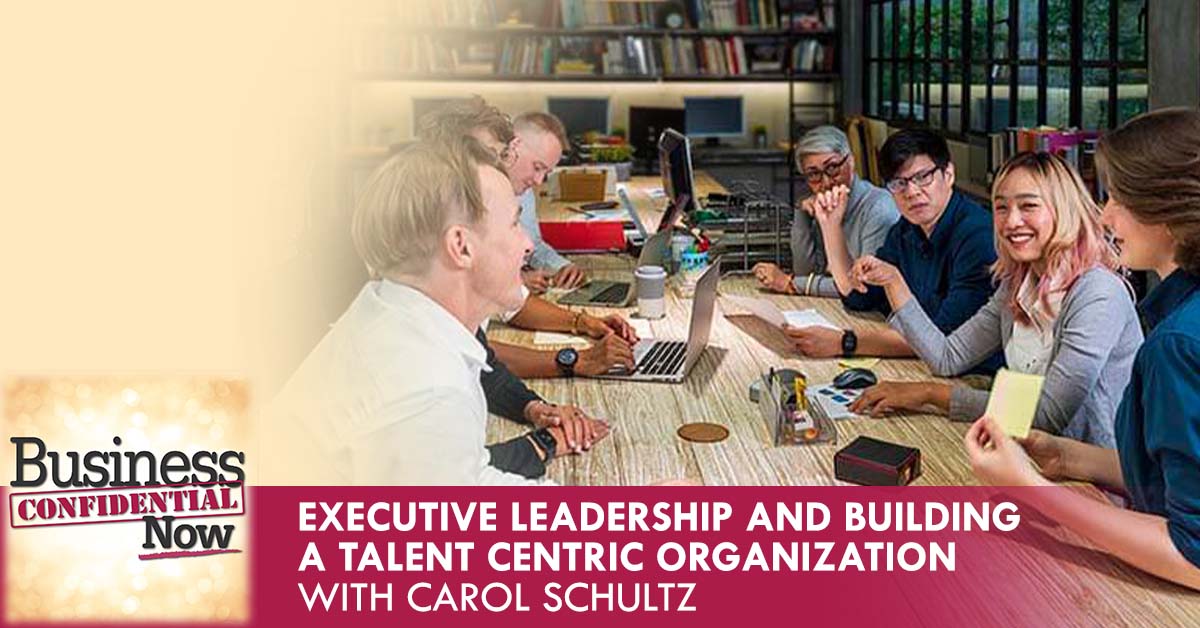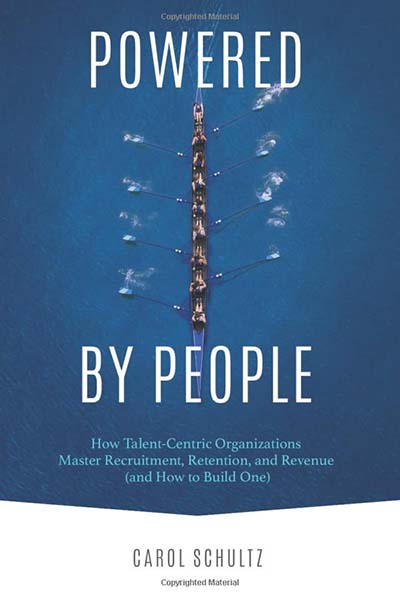
Photo Credits: © iStock Credit: Akarawut Lohacharoenvanich
A talent-centric organization addresses the needs of individuals based on their strengths and weaknesses. What processes do you have in your company that ensures that the people you’re recruiting are the best fit for your job offers? Join your host Hanna Hasl-Kelchner as she sits down for a conversation with Carol Schultz about engaging, managing, and retaining employees to elevate processes and drive growth. Carol transforms executive leadership with custom strategies, coaching, and an authentic approach. In this episode, she shares valuable insights on identifying processes, effective recruiting, and retaining human resources that a company needs. She explains vital concepts on developing, sourcing, and evaluating workforce planning to ensure you get the right people in your business.
—
What You’ll Discover About Building A Talent Centric Organization
- Great ways of crafting job descriptions in job advertisements
- Difference between employee development or retention in a talent centric organization
- Important functions of a talent centric organization
- What a talent centric organization do differently when it comes to recruiting
- Why building a talent centric organization matters
- What business leaders need to know about a talent centric organization
GUEST
 CAROL SCHULTZ, founder and CEO of Vertical Elevation. She is a talent equity and leadership advisory expert. Recognized for her proficiency in corporate leadership, Carol has spent three decades helping executives gain clarity in their careers, make bold leadership moves, and create cultures of performance. Schultz and her team have helped hundreds of companies—from seed stage pre-initial public offerings to publicly traded companies—transform their organizations and create sustainable, talent-centric cultures that run at maximum efficiency. She’s the host of the popular podcast Authentically Successful and author of the new book Powered By People: How Talent-Centric Organizations Master Recruitment, Retention, and Revenue (and How to Build One).
CAROL SCHULTZ, founder and CEO of Vertical Elevation. She is a talent equity and leadership advisory expert. Recognized for her proficiency in corporate leadership, Carol has spent three decades helping executives gain clarity in their careers, make bold leadership moves, and create cultures of performance. Schultz and her team have helped hundreds of companies—from seed stage pre-initial public offerings to publicly traded companies—transform their organizations and create sustainable, talent-centric cultures that run at maximum efficiency. She’s the host of the popular podcast Authentically Successful and author of the new book Powered By People: How Talent-Centric Organizations Master Recruitment, Retention, and Revenue (and How to Build One).
—
Executive Leadership And Building A Talent Centric Organization With Carol Schultz
In this episode, I’m delighted to welcome a special guest. She’s Carol Schultz. She is a talent equity and leadership advisory expert who is also the Founder and CEO of Vertical Elevation. Carol and her team have helped hundreds of companies, everything from seed stage IPOs to publicly traded companies. She’s helped them transform their organizations and create sustainable talent-centric cultures that run at maximum efficiency. She’s also the author of Powered by People: How Talent-Centric Organizations Master Recruitment, Retention, and Revenue. This whole talent-centric organization thing is intriguing, and I can’t wait to learn more.
—
Welcome to the show, Carol.
Thanks, Hanna. It’s great to be with you.
I’m going to cut to the chase here. In a nutshell, what is a talent-centric organization, and how does it differ from the traditional hiring and talent management that businesses have been doing for years?
At a high level, a talent-centric organization is one that first and foremost has its focuses on its people. Not lip service, but the rubber meets the road. That’s where they are. It is an organization where the leadership team or the executive committee, whatever you’d like to call them, get the understanding and the value of the importance of being aligned.
They are aligned in their vision, business strategy, and how they’re going to get their mission to achieve their vision. At that point, then and only then, can a company build a talent strategy to support the aligned executive team’s vision and strategy. Does that answer your question? At a high level, that’s in its simplicity, what it is.
Talent acquisition done properly is extremely difficult to get right. Share on X
That’s a high level, and I appreciate that, but let’s try and bring it down to Earth because I’m sure there are people out there reading going, “That’s what we’re doing.” You said something interesting about not paying lip service to it. Where is that slip of the lip that causes things to you, they say one thing, but it’s not happening. Help me understand the bridge between those two.
For example, a CEO may say, “We have to get the right talent. That’s important.” When it comes to taking action on that, they may have an HR person with talent reporting to them. I’ve said it over again for years, “Talent has no business reporting to human resources because human resources don’t understand what quality talent acquisition is.”
It ends up looking like a cost center instead of the area that ultimately is going to drive all your revenue. When you bring the right people in that are aligned with your business strategy and vision, they’re going to drive your revenue and be happy to do so, whether it’s sales, engineering, customer success, APA, or whatever that role might be. Some CEOs will say, “No, we’re going to hire internal recruiters.” They end up hiring people that aren’t qualified. They don’t know what it is to be a head hunter.
What are they missing? HR does a lot of initial screening of resumes and so forth.
They shouldn’t be.

Powered by People: How Talent-Centric Organizations Master Recruitment, Retention, and Revenue (and How to Build One)
Why not?
This is not scientific, but in the research, I have done, when I look up whatever that chief human resources person is, it might be a CHRO, VP of people, or chief people officer, whatever that top person is in that role. I have found that 98% had zero experience in talent acquisition. The other 2%, who maybe started out that way and moved into HR, doesn’t happen. There’s a reason they’ve moved into HR. Talent acquisition done properly is extremely difficult to get right. Why would you put the most important function of your company underneath human resources?
People don’t know what you know, Carol, and that’s exactly why I want you here. Everybody says, “People are our most important resource.” If we’re serious about a talent-centric organization where a company can achieve the alignment that you talked about initially here, it’s great. What is it about talent acquisition that requires laser focus in order to achieve a talent-centric organization?
In my experience, what happened is, in the mid-’90s, for those of us who were old enough to remember that, the internet came about. All of a sudden, companies thought, “We can put a job ad online. Instead of getting a 1 by 2-inch space in the paper, we get a whole page to do this. We can hire people to sift through all the resumes that are going to be flooding into our company.” That, in my opinion, destroyed talent acquisition. It minimized it. It made it so that people thought, “This is easy. We’ll put somebody and have them sift through all the fantastic resumes.” Who’s out there looking for a job? Who’s reading the one ad?
Nobody at that point.
Head hunting is about searching for the best people to fit the role of the job you’re offering. Spamming people on LinkedIn is not head hunting. It's not recruiting. Share on X
In general, who’s reading the one ad?
It’s the people looking for jobs.
Is that who companies should be looking to hire people who need a job?
Sometimes.
Sometimes maybe, but that’s not what headhunting is about. Headhunting is going out and searching for the best people to fit the role. The internet has done wonderful things like give us massive databases, LinkedIn, and ZoomInfo. They’re all over the place. They’ve also destroyed the business because people have not been trained properly on how to do talent acquisition. I’m generalizing here. Many people have not been trained. Most, in my opinion, have not been trained. Spamming people on LinkedIn is not headhunting. It’s not recruiting.

Talent Centric Organization: When you bring the right people in your company that are aligned to your business strategy and vision, they’re going to drive your revenue and they’re going to be happy to do so.
What does a talent-centric organization do differently when it comes to recruiting?
The first thing they do is get the executive team in alignment. I will ask each member of the executive team in discovery, and this includes, of course, the founder and/or CEO, whoever that person tends to be. I love the board to get involved in these conversations because it’s important to make sure that the board and the executive team are aligned.
There are a couple of important questions that I ask. These conversations will go for about two hours. One of the important questions is what’s your vision for the company. I listened for, am hearing the same thing out of each individual’s mouth? Not necessarily exactly the same words, but the same message. I will also ask questions like, “In your opinion, what do you believe is the most important department or function in the organization that contributes to its success?”
It is inside of those two questions that I start to learn if this team even be aligned. On a scale of 1 to 10, where are they? I will talk to each person about their background, professional progression, why they took this job, and so on and so forth. It starts to give me the ability to report back to the CEO, who’s typically the person who hires me, to say, “Here’s what I have found out. From a vision standpoint, you’ve got six people on your executive committee, including yourself. I got different answers from four of them about what your vision is.”
The CFO said, “He’s the most important person or department because he or she is managing the money. The salesperson thinks they’re the most important in the department because they’re the ones generating revenue. Technology, software, whoever the chief technology officer, they’re the most important function because, without them, salespeople don’t have anything to sell.” This tells me you’re out of alignment in these things. We can determine what we need to do to get you into alignment. There’s always a possibility, Hanna, that somebody on your executive committee may need to be replaced.
Your goal as a talent acquisition manager is not to remove and get rid of people but to align everyone. The more open people can be with you, the better. Share on X
I will talk about this in advance. That’s not my goal. I talked to each individual. My goal is not to remove people. My goal is to align everyone. This is not about finding what’s wrong and getting rid of people. You have to look at it glass half full. That could include coaching or teaching people how to communicate effectively. Communication is huge. Many people don’t know how to effectively communicate with their subordinates, peers, and even to their up above. They don’t look at how the language I use impacts someone else. That’s the first piece, and that would include coaching.
Once that is up and running and we’re moving toward alignment, we can look at, based on what we’re now learning, what talent strategy we need to put in place. Does that mean hiring recruiters, training recruiters, teaching them how to write position descriptions, and teaching them how to be head hunters? It’s different for every company depending on where they might be in space at that exact time.
That sounds comprehensive. That’s for sure.
It’s like a land and expands model. You have to do one step at a time because if I walk in and say, “This is what we’re going to do.” It is incredibly overwhelming.
I’m interested in this vision alignment because I find it hard to believe that if you’re talking to a senior leadership group, they’re not going to think that my department is the most important because, as you said, “Without sales, you don’t have revenue. Without finance, you don’t have the accounting and so forth.” They’re all going to bolster their own status in the organization, if nothing else, for self-preservation. Could you give me an example of where these different pieces are aligned? What would demonstrate alignment to you?

Talent Centric Organization: The internet has done wonderful things like massive databases, LinkedIn, ZoomInfo, and more. But they’ve also destroyed the business because people have not been trained properly on how to do talent acquisition.
What would demonstrate alignment is that the example I used was a conversation I had with a CEO, “If you had talked to my CFO, here’s what he’d say.” I said, “What’s your answer? He said to me, “I think they’re equally as important.” I said, “Bravo, how is it that your leadership team doesn’t get that? They haven’t done the work on it. That’s what that means. To educate, inform, and dig in.” If the chief sales officer says to me, “My department is the most important, Carol.” I’m going to ask him why they think that is.
It’s all about me asking questions to determine what’s underlying how they think. That’s what great coaches do. Ask questions and dig into where the blind spots are. What are they not seeing? That’s what COVID lived for us. It was living in a blind spot for everyone. It works the same way throughout organizations. You don’t know what you don’t know.
That’s one reason why I did this show. It’s because it’s business issues hiding in plain view that matter to the bottom line. Either thing you knew and forgot because you’re focused on other things or things you didn’t know and should know. It especially hurts the smaller organizations that don’t have as deep a bench or as deep a pocket to afford the mistakes they make. That’s the purpose behind this. Alignment because they need to be working in synchronicity with each other and not trying to one-up each other.
One other thing, Hanna. Things might not be operating in a well-oiled way, but it’s not about looking at it from like, “You’re broken. Let’s fix you.” Higher operating is not the most effective way to be doing it to achieve what you’re looking to achieve. That’s a different way of explaining it than, “You’re broken. What do you need to work?”
That puts everybody’s defenses up.
Great coaches ask questions and dig into where the blind spots are. Share on X
It does, but that’s about knowing how to effectively communicate. I could tell you stories about managers, and I’m like, “I can’t even believe they would talk to people that way.”
They do in a past life. I practice law in-house. Believe me. Those things always landed on my desk. You’re like, “You said what? You put what in an email?”
What were you thinking?
That’s the point. They weren’t being very self-aware. You get things in alignment. Tell me about the job descriptions because you made an interesting point about how the internet threw the doors wide open, and you’re right. In the old classified ads, you had to pay by the column, inch by the word. People were judicious in what they put in there, and on the internet, anything goes. If a headhunter is recruiting and calling people, a person is going to want to know like, “What’s in it for me? Why is this an attractive position?” You still need some description. What is a good way to craft those descriptions that are different from what people were doing before?
The way I do it and the way professional headhunters do it is you start out with a kickoff meeting with the stakeholders for a particular search. Depending on the position, there are 40 to 50 questions I would ask in advance to the stakeholders in those kickoff meetings. We talked about the company culture and how it’s structured.

Talent Centric Organization: There’s always a possibility that somebody on your executive committee may need to be replaced.
We talk about the actual responsibilities for the particular position, like what are the skills and abilities that somebody needs to have. What are the communication abilities a person needs to have? What’s our culture like? All the different areas that will help this individual excel in the position. Out of those conversations, I or you can now build and write a position description. What people tend to think about in a “job description” is if you look at a lot of them online, it’s a litany of bullet points. It doesn’t talk about what it is that a candidate would want to know to spark their interest.
Part of the problem is gone are the days. There are still people who do it this way. I still did it this way. I’d like to think most retained professionals do it this way, but I know there are some that don’t, where you go in and spend time with the individual, “Here’s who I am. The reason I’m calling is this.” It’s Sales 101, feature benefit, “I’m calling because I’d love to spend some time with you. I’m getting to know you a little bit. I’ve been retained by such and such a company. I’m working on a search for so-and-so.” Any internal person can say this, too, “I’d love it if you’d be open to having a conversation with me. I’m not assuming anything about your situation. I’m not thinking you’re looking to leave your job.”
People are so used to getting calls from headhunters, Hanna, and all they want to do is pitch them jobs. They send them out on LinkedIn or through email. I’ve gotten them from retained professionals. I’m mortified. I thought, “Who taught you how to search? You don’t know what you’re doing.” This isn’t, “Hi, I’m with such and such a company. I’ve got a client looking for this. Would you be interested?” Who’s the idiot that retained you? That’s what I’d like to know.
I shouldn’t say who’s the idiot retained you because there are a lot of people out there. They give you a line, and you don’t know any better. It’s a matter of approaching the person. When I did search work, I never presented a candidate until I’d had typically three conversations with that person. Each of them would go easily 45 minutes to an hour. That’s what somebody is paying me to do. This is not about sending a resume out and having somebody that doesn’t understand it look over a resume and throw it through to the job manager. I can’t tell you the conversations that I’ve had over the years. My HR and internal recruiters are flooding these resumes. They’re worthless.
Some people don’t want to put the work in, and there are different levels of professionalism in every industry and niche. I applaud you’re doing the work, and shame on the ones who don’t and figure, “I’ll throw spaghetti against the wall and see what sticks.” That’s what happens. I understand that there should be a rigorous screening process, which is only fair because you’re bringing in somebody, and you don’t have to fire them the next day. You want to make sure there’s a good fit. Let’s say you bring the right person in. How do you keep them there? What is different about a talent-centric organization when it comes to employee development or retention?
We need to move into an area where people are communicating effectively about culture and structure so they could align with the company. Share on X
It’s a matter of asking the candidate throughout the interview process. When you know enough about we’re interested. Maybe you had the first date, and you think you want to have a second date. You’re starting to get interested in them, and it’s always the candidate’s responsibility to sell you on why they should be interested in hiring you. However, it’s also important in that process for companies to ask, “Tell me what you’re looking for in an organization. Are you looking to move up the food chain? What are you looking to do? How long would you like to stay with the company? What’s it going to take to keep you here for five years?” Companies don’t ask those questions, and it’s important that they ask those questions.
I’ve had one person only say to me, “Why would you ask that?” This is about communicating with people. You want to get the best fit. We’re hiring a chief sales officer. How long do we want that person to stay with us? If we want that person to stay with us for at least five years, we better be looking at that person’s background. If they’ve had a job every year to two, probably we don’t want to look at that person.
It’s fine if it’s happened once or twice. Everybody is entitled to make mistakes. Why do you hire somebody who’s had a job every 1 or 2 years if you want them to stay with you for at least 5? We need to determine that as a company. Each different role would require maybe a different amount of time. How long would you want to keep that person? That’s a piece of it.
A piece of it is, “Tell me what you’re looking for, Mr. Candidate or Ms. Candidate? What do we need to do for you to stay here for at least the next five years? Is it leadership development? Is it getting you an executive coach? Is it making sure that your team gets the development they need? What does that look like for you?” We need to move into an area where people are communicating well more effectively about these things.
Sometimes people are afraid, and they’re not willing to put all their cards on the table any more than a company. There are some boring parts to this position, so they try to smooth that part over. The candidates are in the same situation. If they want the job, they’re going to put their best foot forward and try to minimize or dismiss anything they think will detract from that. That’s going to be a hard thing, and I applaud you for taking the time to drill down and try and find as best a fit as possible, given these hesitancies that people are automatically going to bring into the organization.

Talent Centric Organization: Business leaders need to understand that either they have a problem that might need fixing or if they think they have an issue, they need to be open to the discovery. If that business owner or CEO doesn’t truly believe that their organization could do better and needs work, you can’t do it.
It’s one thing to talk about recruiting, and another thing to talk about is we got to get all of this alignment, and we have to recruit according to it. Tell me about a situation where an organization already has a reasonable size workforce. The senior leadership might be aligned, even if it’s a small company, with the owner, the founder, and their immediate senior support. Some of the mid to lower-level workers may not be aligned. How do you make that shift happen in a talent-centric organization?
If you’ve got good workers, you don’t want to get rid of them and say, “We’re not aligned down here.” It is important, regardless of the size of the organization, from place to start seeing the CEO and that person taking the first step to say, “This is what we’re committed to.” Maybe it’s a once or twice a month meeting with the organization and an all-hands meeting. It depends on the company, the size, what those employees look like, and what their jobs are. Do they feel like you’re part of the organization? Does somebody in a warehouse at Amazon feel like they have a say up to the CEO? I don’t know.
That could be why there’s more unionization happening to give them a seat at the table.
It’s a matter of the CEO recognizing it, going out in saying, and I’ve had these conversations, “We want to know what you think.” That’s the distinction here. When you say, “It’s great that I’m committed to wanting to drill down.” Are there always going to be people who sit there and blow sunshine on your script? Of course, there are.
If you know how to communicate with your candidates and your employees in a way, I refer to as a culture of feedback, they get, “Authentically, we want to hear from you. This is not about us sitting in an Ivory tower, making decisions for you. We want to know how to make things better for you.” When people see that from the CEO, especially, it will start to trickle down through your organization and those managers, “I, as a CEO, want your opinion. Each of you, I want you to be able to go to your managers and talk about what’s working and what’s not working for you. You have my word that you will not get thrown under the bus.”
That last part is key because there are all kinds of employee satisfaction and engagement surveys. It’s like the lip service you talked about earlier. The worst part is when, especially in a small group, somebody tells them and the head of that department or the company, “Who is it? We want to know.” That person starts to get ostracized.
What you’re talking about requires a tremendous amount of trust. I applaud those organizations that can strive for it, especially those that can achieve it, because all the oars are hitting the water at the same time and going in the same direction. You can harness all that talent, which is what you’re paying for anyway, but some of it is dormant on the shelf. We could talk about this for a long time, but I know that our readers need to go out and do other things too. What do you think is the most important thing business owners and leaders need to know about a talent-centric organization?
Business leader or owner needs to understand that they have a problem that might need fixing or work, or if they think they have an issue, they need to be open to the discovery. That is the most important thing because the buck stops there. If that business owner or CEO doesn’t truly believe that their organization could do better and needs work, the whole process, you can’t do it.
Carol, thank you so much. I appreciate your time and sharing your experience and helping us learn more about what it takes to become a talent-centric organization, what it is, why it matters, and how to achieve it. If you’re reading and you’d like more information about Carol Schultz, her business, Vertical Elevation, or about her exciting new book Powered by People. Carol is also a host of her own podcast, Authentically Successful.
Please be sure to tell all your business friends about the show and leave a positive review because the more you dive into all of the past episodes and follow the show going forward, the more you’ll be able to see issues hiding in plain view that matter to your bottom line. Use those tips and strategies to grow your company and be more successful. Thanks so much for reading, have a great day and an even better tomorrow.
Important Links
- Vertical Elevation
- Powered by People: How Talent-Centric Organizations Master Recruitment, Retention, and Revenue
- Authentically Successful Podcast
- https://www.LinkedIn.com/in/CarolBSchultz/
- https://Twitter.com/CarolBSchultz
- How To Systematize Your Business And Improve Your Processes With Alexis Kingsbury – previous episode
- If you liked this interview you might also like these Team Building episodes
Join, Rate and Review:
Rating and reviewing the show helps us grow our audience and allows us to bring you more of the rich information you need to succeed from our high powered guests. Leave a review at Lovethepodcast.com/BusinessConfidential
Joining the Business Confidential Now family is easy and lets you have instant access to the latest tactics, strategies and tips to make your business more successful.
Follow on your favorite podcast app here as well as on Twitter, Facebook, YouTube, and LinkedIn.
Download ♥ Follow ♥ Listen ♥ Learn ♥ Share ♥ Review ♥ Comment ♥ Enjoy
Ask Questions or Recommend a Topic/ Guest:
- Use our convenient Get in Touch form
- OR e-mail feedback(at)BusinessConfidentialRadio.com
Disclosure:
This post may contain links to products to products on Amazon.com with which I have an affiliate relationship. I may receive commissions or bonuses from your actions on such links, AT NO ADDITIONAL COST TO YOU.
